Are you a freelancer, general partnership or private limited company and looking for a collaboration agreement? This model is for businesses looking to enter into a collaboration agreement for a definite or indefinite period of time.
- What is a collaboration agreement?
- Example 1: All-in-one services
- Example 2: Collaboration of freelancers
- Example 3: Research product improvement
- Why is a collaboration agreement important?
- Is a collaboration agreement mandatory?
- What should be in a collaboration agreement?
- Purpose
- Duration
- Investment
- Costs, profits and losses
- Secrecy
- Competition
- Liability
- Intellectual property (IP)
- Advantages and disadvantages
- Risks
- Difference between joint venture and collaboration
- Other forms of collaboration
- Concluding considerations
What is a collaboration agreement?
In a collaboration agreement, two (or more) business partners make agreements to achieve a goal together. This can be anything. Think, for example, of doing research, developing a new product or carrying out a project.
The nature and content differs for each collaboration. Below are three examples of possible forms of collaboration.
Example 1: All-in-one services
De Koffieman BV sells organic coffee beans to companies and Esko VOF sells espresso machines to the hospitality industry. Regularly, Esko is asked whether they can also supply coffee beans. This is why they approach De Koffieman for a collaboration.
After some market research, they decide to offer an all-in-one package together, so customers can buy an espresso machine incl. coffee subscription. Since agreements need to be made about costs and invoicing, among other things, they decide to lay this down in a collaboration agreement.
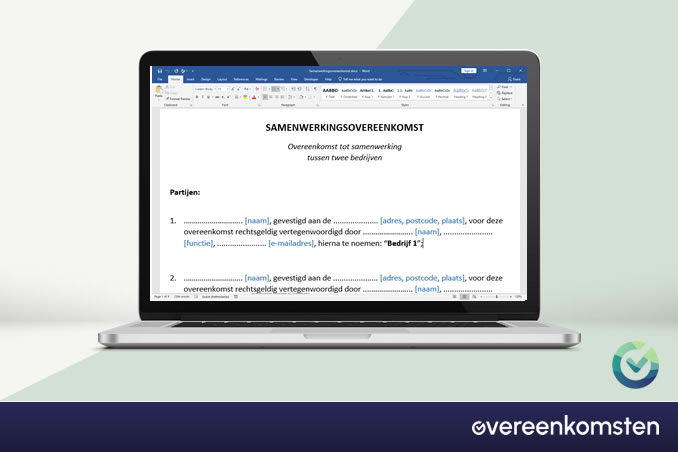
Example 2: Collaboration of freelancers
Anne works as an independent consultant. Among other things, she teaches courses on compliance. Because of a change in financial regulations, a large Dutch bank has asked her to provide 50 training courses. That task is too big for her alone.
She asks Rob, who is also a freelancer, to share the activities. The bank thinks this is a good idea, but requires them to draw up a collaboration agreement and put forward a quotation together. This will also include agreements on sickness replacement so that the training cycle is completed by a certain date.
Example 3: Research product improvement
Two electric bike manufacturers buy their parts from suppliers. They are both dissatisfied with one of those parts. It also appears that no suppliers can be found worldwide who can deliver the desired quality.
Both parties want to explore the possibility of producing this part themselves. The cost of doing so is high. Therefore, they enter into a collaboration agreement in which this research is carried out under strict confidentiality.
Why is a collaboration agreement important?
The law does not say much about collaborations. Therefore, in case of possible conflicts, there is nothing to fall back on. Conditions must therefore be laid down in advance. Once signed by both parties, the document is legally valid.
During the drafting process, you will be forced to think carefully about the details of the collaboration. Who will do what, how much time will it take and how will you deal with confidentiality and intellectual property? This creates clarity and prevents hassle, both during the journey and afterwards.
Is a collaboration agreement mandatory?
No. Often the collaboration has been going on for a while before it is decided to put agreements on paper. If you do not initially want to draw up a contract yet, it is wise to sign a nondisclosure agreement.
What should be in a collaboration agreement?
A good agreement should include at least the following things:
- Purpose
- Duration
- Investment
- Cost
- Profits and losses
- Secrecy
- Competition
- Liability
- Intellectual property
- Privacy and personal data
- (Early) termination
The bigger the stakes, the more issues are involved. Then it is wise to engage a lawyer to check or tailor the contract. The practical details are usually worked out in a separate quotation or project plan incl. budget.
Purpose
Common reasons for starting to work together are:
Often, one party has knowledge that the other does not have. Another example is that one party has a large network and the other party has a product that fits in well. In our model, you describe the goal you have in mind, but also how you support and strengthen each other in this.
Duration
You can choose a collaboration agreement for a definite or indefinite period. A term can be agreed or an event can be established that leads to (early) termination. In our example, it is also possible to automatically extend the contract by the same term after the expiry of a certain date.
When it comes to an indefinite collaboration, each party has the right to terminate it at any time. It is important to agree on a notice period. You can determine this by mutual agreement and include it in the contract.

Investment
Investment refers to all forms of investment. E.g. money, but also time and personnel. Depending on the type of collaboration, you can think of:
- Financial resources;
- Knowledge, expertise and experience;
- Customers, relationships and outlets;
- Software, data, machines, etc.
In the collaboration agreement, you lay down what will be invested once, but also how many working hours are expected from both parties on average per month. Our example contains the most common options. You can add or remove them yourself.
Costs, profits and losses
The simplest way is to divide all costs, profits and any losses in a certain ratio. You maintain accounting records and settle payments and receipts with each other once a month or quarter.
You can also choose to do this in proportion to investments made and labour hours worked. Another option is for one party to pay the other a so-called fixed fee per product sold, hour worked or new customer.
Finally, in the collaboration agreement, you fill in whether expenses above a certain amount must be discussed in advance and you agree on who sends invoices to the customer. Our example shows the most common allocation options.
Secrecy
You obviously don’t want confidential information to be out on the street. Our model includes a section on what is and is not covered by confidentiality. It also contains rules on giving permission to share information with third parties.
Upon written request and in any case upon termination of the agreement, all information received from the other party is returned or destroyed.
Competition
Our model includes a non-competion clause in which you prohibit or authorise each other to enter into similar collaborations with others during the agreement and/or after its expiry. You can also link an area (region or country) to this.
Competition agreements must be reasonable. For example, you may not impose an indefinite ban on collaboration. This also applies to the territory. A ban for the whole of the Netherlands, while you only operate in Utrecht, can be challenged legally.
Finally, a collaboration agreement should never violate competition law. If it should lead to the formation of a cartel, for instance, you could be fined. If you want to impose strict rules on each other, it is wise to have them checked by a lawyer.
Liability
What do you do and who bears the consequences if someone fails to honour their agreements or if damage occurs. This could be through inadvertence or by accident. It is important to agree that everyone is liable for their own actions. This is clearly stated in our model.
The exception, and this makes sense, is if the other person has acted intentionally or through their own fault. Furthermore, a situation may arise where no one could predict in advance that it would happen. Here, you indemnify each other for the consequences.
Intellectual property (IP)
Intellectual property rights mean all (un)registered copyright, licence, trademark, patent and similar rights. Sometimes you share information which is subject to IP rights. To prevent the other from misappropriating this information, you make agreements on the use of each other’s property.
Of course, it is also possible that a new idea, product or service emerges from the collaboration that can be officially registered. Our collaboration agreement assumes a 50-50 split when registering a new IP right. You can adjust this yourself.
Advantages and disadvantages
Advantages of collaboration have mainly to do with scalability. The so-called 1+1 =3 principle. Apart from the risks you run in doing so, there are always disadvantages. Keep these in mind when drawing up agreements, so that you can minimise them wherever possible.
Advantages
- Better services
- Competitive advantage
- Continuity and business growth
- Inspiration and creativity
- Knowledge sharing and development
Disadvantages
- More dependence
- Less flexibility
- Slower decision-making
- Higher overheads
- Less control
Often the lead time is long. Especially in the beginning, overheads increase. Think of meetings, miscommunication and wrong decisions. The combination of uncertainty and delay in seeing results is regularly a source of conflict.
Risks
US research shows that about 70% of business partnerships fail. The fact remains that you cannot cover all risks in a collaboration agreement. Just think of disagreement, lack of commitment or loss of trust.
External factors also play a role, of course. The economy is not doing well or customers are not interested in your product. The only really good advice for limiting risks is: prepare well and back up your feelings with facts. You can use our model as a legal framework, but also as a substantive checklist.
Difference between joint venture and collaboration
A joint venture is also simply a collaboration between two (or more) parties that wish to maintain their independence as businesses. The only difference is that a joint venture is registered as a business at the Chamber of Commerce, e.g. as a general partnership or subsidiary of a private limited company.
In an ordinary collaboration agreement, no separate company is set up. The partners therefore continue to do their own bookkeeping and VAT returns and do not open a joint bank account. Costs and profits are settled between them.
Other forms of collaboration
Many things are of course akin to a collaboration, but you cannot use a collaboration agreement in every situation. If there is e.g. a power relationship, such as between a client and contractor, you need a different contract.
Below are some key collaboration forms for illustration.
Hire
If you hire out your services as a freelancer, you will need a contract for the provision of services. Unlike the collaboration agreement, there are legal requirements for this, among other things to ensure that no employment relationship arises.
Distribution
Producers often choose to work with distributors. They are responsible for resale in a certain area. Usually this is for their own account and risk. In that case, you need a distribution agreement.
Franchise
Shops and restaurants often have locations across the country. If there is a formula, it is possible for independent entrepreneurs to run their own outlets. These types of partnerships are documented in a franchise agreement.
Agency
Insurers, travel agencies and cosmetics companies often work with commercial agents. These are independent entrepreneurs who sell products on behalf of the company. They receive a commission per product sold. For this, you use an agency agreement.
Concluding considerations
You probably already have a good idea of what your partnership will look like and want to put it down on paper quickly. Unfortunately, there is no ready-made collaboration agreement that you can sign right away.
Even if you hire a lawyer, they will ask for a lot of information. You will find that you will come across things in our model that you have not yet thought about.
Download our collaboration agreement
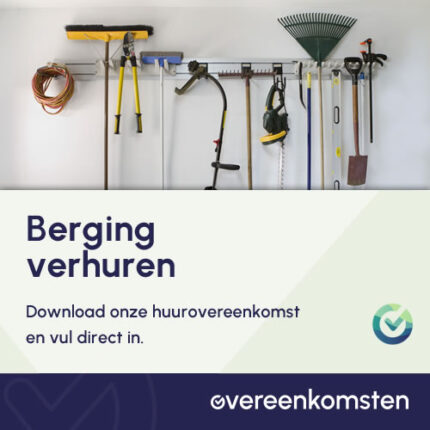





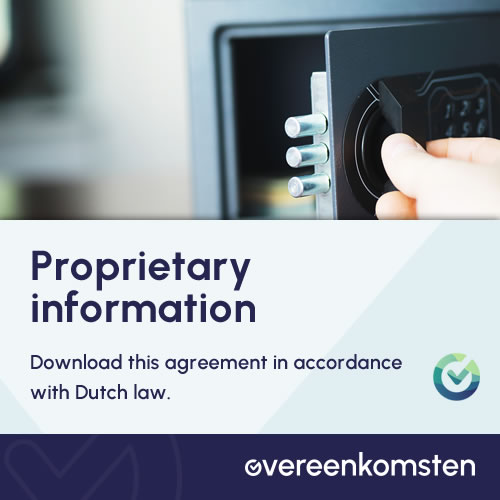
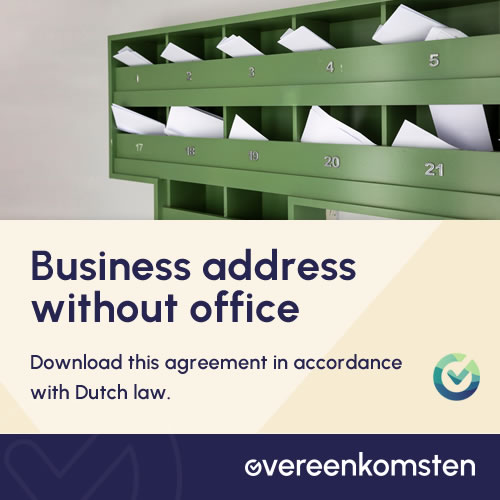
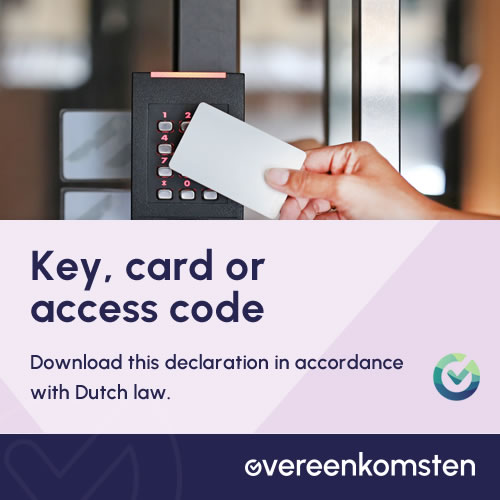

M. Sikkink –
Very good and extensive template.
Stijn Koster –
Professionele partij. Duidelijke en actuele modellen. Ook het aanbod met Engelse contracten groeit gestaag.